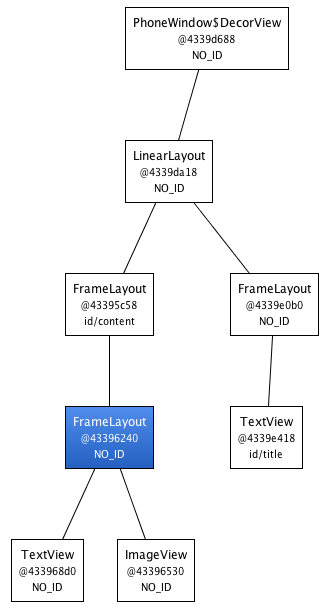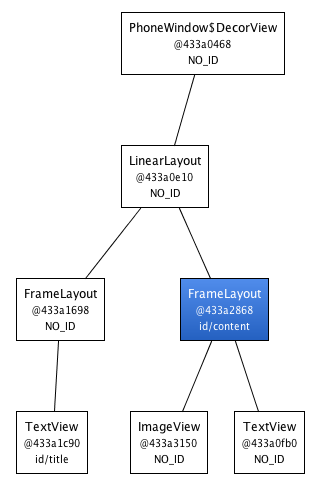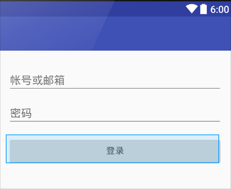編輯:Android資訊
在開發中UI布局是我們都會遇到的問題,隨著UI越來越多,布局的重復性、復雜度也會隨之增長。Android官方給了幾個優化的方法,但是網絡上的資料基本上都是對官方資料的翻譯,這些資料都特別的簡單,經常會出現問題而不知其所以然。這篇文章就是對這些問題的更詳細的說明,也歡迎大家多留言交流。
首先用得最多的應該是include,按照官方的意思,include就是為了解決重復定義相同布局的問題。例如你有五個界面,這五個界面的頂部都有布局一模一樣的一個返回按鈕和一個文本控件,在不使用include的情況下你在每個界面都需要重新在xml裡面寫同樣的返回按鈕和文本控件的頂部欄,這樣的重復工作會相當的惡心。使用include標簽,我們只需要把這個會被多次使用的頂部欄獨立成一個xml文件,然後在需要使用的地方通過include標簽引入即可。其實就相當於C語言、C++中的include頭文件一樣,我們把一些常用的、底層的API封裝起來,然後復用,需要的時候引入它即可,而不必每次都自己寫一遍。示例如下 :
my_title_layout.xml
<?xml version="1.0" encoding="utf-8"?>
<RelativeLayout xmlns:android="http://schemas.android.com/apk/res/android"
android:layout_width="match_parent"
android:id="@+id/my_title_parent_id"
android:layout_height="wrap_content" >
<ImageButton
android:id="@+id/back_btn"
android:layout_width="wrap_content"
android:layout_height="wrap_content"
android:src="@drawable/ic_launcher" />
<TextView
android:id="@+id/title_tv"
android:layout_width="wrap_content"
android:layout_height="wrap_content"
android:layout_centerVertical="true"
android:layout_marginLeft="20dp"
android:layout_toRightOf="@+id/back_btn"
android:gravity="center"
android:text="我的title"
android:textSize="18sp" />
</RelativeLayout>
include布局文件:
<?xml version="1.0" encoding="utf-8"?>
<LinearLayout xmlns:android="http://schemas.android.com/apk/res/android"
android:layout_width="match_parent"
android:layout_height="match_parent"
android:orientation="vertical" >
<include
android:id="@+id/my_title_ly"
android:layout_width="match_parent"
android:layout_height="wrap_content"
layout="@layout/my_title_layout" />
<!-- 代碼省略 -->
</LinearLayout>
這樣我們就可以使用my_title_layout了。
使用include最常見的問題就是findViewById查找不到目標控件,其正確的使用形式如下:
View titleView = findViewById(R.id.my_title_ly) ;
TextView titleTextView = (TextView)titleView.findViewById(R.id.title_tv) ;
titleTextView.setText("new Title");
首先找到include的id, 例如這裡include設置的id為“my_title_ly”,然後再對獲取到的titleView.findViewById來查找目標布局中的子控件,例如title_tv就是my_title_layout.xml中定義的子控件。因此我們如果需要查找控件的話,可以設置include標簽的id,通過這個id獲取include對應的view以後,再通過對這個view進行findViewById才能正確查找。如果你設置了include標簽的id,然後通過被include的布局的root view的id來查找子元素的話,則會報錯,如下 :
View titleView = findViewById(R.id.my_title_parent_id) ;
TextView titleTextView = (TextView)titleView.findViewById(R.id.title_tv) ;
titleTextView.setText("new Title");
這樣會報空指針異常,因為titleView沒有找到,會報空指針。那麼這是怎麼回事呢? 我們來分析它的源碼看看吧。對於布局文件的解析,最終都會調用到LayoutInflater的inflate方法,該方法最終又會調用rInflate方法,我們看看這個方法。
/**
* Recursive method used to descend down the xml hierarchy and instantiate
* views, instantiate their children, and then call onFinishInflate().
*/
void rInflate(XmlPullParser parser, View parent, final AttributeSet attrs,
boolean finishInflate) throws XmlPullParserException, IOException {
final int depth = parser.getDepth();
int type;
// 迭代xml中的所有元素,挨個解析
while (((type = parser.next()) != XmlPullParser.END_TAG ||
parser.getDepth() > depth) && type != XmlPullParser.END_DOCUMENT) {
if (type != XmlPullParser.START_TAG) {
continue;
}
final String name = parser.getName();
if (TAG_REQUEST_FOCUS.equals(name)) {
parseRequestFocus(parser, parent);
} else if (TAG_INCLUDE.equals(name)) {// 如果xml中的節點是include節點,則調用parseInclude方法
if (parser.getDepth() == 0) {
throw new InflateException("<include /> cannot be the root element");
}
parseInclude(parser, parent, attrs);
} else if (TAG_MERGE.equals(name)) {
throw new InflateException("<merge /> must be the root element");
} else if (TAG_1995.equals(name)) {
final View view = new BlinkLayout(mContext, attrs);
final ViewGroup viewGroup = (ViewGroup) parent;
final ViewGroup.LayoutParams params = viewGroup.generateLayoutParams(attrs);
rInflate(parser, view, attrs, true);
viewGroup.addView(view, params);
} else {
final View view = createViewFromTag(parent, name, attrs);
final ViewGroup viewGroup = (ViewGroup) parent;
final ViewGroup.LayoutParams params = viewGroup.generateLayoutParams(attrs);
rInflate(parser, view, attrs, true);
viewGroup.addView(view, params);
}
}
if (finishInflate) parent.onFinishInflate();
}
這個方法其實就是遍歷xml中的所有元素,然後挨個進行解析。例如解析到一個標簽,那麼就根據用戶設置的一些layout_width、layout_height、id等屬性來構造一個TextView對象,然後添加到父控件(ViewGroup類型)中。標簽也是一樣的,我們看到遇到include標簽時,會調用parseInclude函數,這就是對標簽的解析,我們看看吧。
private void parseInclude(XmlPullParser parser, View parent, AttributeSet attrs)
throws XmlPullParserException, IOException {
int type;
if (parent instanceof ViewGroup) {
final int layout = attrs.getAttributeResourceValue(null, "layout", 0);
if (layout == 0) {// include標簽中沒有設置layout屬性,會拋出異常
final String value = attrs.getAttributeValue(null, "layout");
if (value == null) {
throw new InflateException("You must specifiy a layout in the"
+ " include tag: <include layout=/"@layout/layoutID/" />");
} else {
throw new InflateException("You must specifiy a valid layout "
+ "reference. The layout ID " + value + " is not valid.");
}
} else {
final XmlResourceParser childParser =
getContext().getResources().getLayout(layout);
try {// 獲取屬性集,即在include標簽中設置的屬性
final AttributeSet childAttrs = Xml.asAttributeSet(childParser);
while ((type = childParser.next()) != XmlPullParser.START_TAG &&
type != XmlPullParser.END_DOCUMENT) {
// Empty.
}
if (type != XmlPullParser.START_TAG) {
throw new InflateException(childParser.getPositionDescription() +
": No start tag found!");
}
// 1、解析include中的第一個元素
final String childName = childParser.getName();
// 如果第一個元素是merge標簽,那麼調用rInflate函數解析
if (TAG_MERGE.equals(childName)) {
// Inflate all children.
rInflate(childParser, parent, childAttrs, false);
} else {// 2、我們例子中的情況會走到這一步,首先根據include的屬性集創建被include進來的xml布局的根view
// 這裡的根view對應為my_title_layout.xml中的RelativeLayout
final View view = createViewFromTag(parent, childName, childAttrs);
final ViewGroup group = (ViewGroup) parent;// include標簽的parent view
ViewGroup.LayoutParams params = null;
try {// 獲3、取布局屬性
params = group.generateLayoutParams(attrs);
} catch (RuntimeException e) {
params = group.generateLayoutParams(childAttrs);
} finally {
if (params != null) {// 被inlcude進來的根view設置布局參數
view.setLayoutParams(params);
}
}
// 4、Inflate all children. 解析所有子控件
rInflate(childParser, view, childAttrs, true);
// Attempt to override the included layout's android:id with the
// one set on the <include /> tag itself.
TypedArray a = mContext.obtainStyledAttributes(attrs,
com.android.internal.R.styleable.View, 0, 0);
int id = a.getResourceId(com.android.internal.R.styleable.View_id, View.NO_ID);
// While we're at it, let's try to override android:visibility.
int visibility = a.getInt(com.android.internal.R.styleable.View_visibility, -1);
a.recycle();
// 5、將include中設置的id設置給根view,因此實際上my_title_layout.xml中的RelativeLayout的id會變成include標簽中的id,include不設置id,那麼也可以通過relative的找到.
if (id != View.NO_ID) {
view.setId(id);
}
switch (visibility) {
case 0:
view.setVisibility(View.VISIBLE);
break;
case 1:
view.setVisibility(View.INVISIBLE);
break;
case 2:
view.setVisibility(View.GONE);
break;
}
// 6、將根view添加到父控件中
group.addView(view);
}
} finally {
childParser.close();
}
}
} else {
throw new InflateException("<include /> can only be used inside of a ViewGroup");
}
final int currentDepth = parser.getDepth();
while (((type = parser.next()) != XmlPullParser.END_TAG ||
parser.getDepth() > currentDepth) && type != XmlPullParser.END_DOCUMENT) {
// Empty
}
}
整個過程就是根據不同的標簽解析不同的元素,首先會解析include元素,然後再解析被include進來的布局的root view元素。在我們的例子中對應的root view就是id為my_title_parent_id的RelativeLayout,然後再解析root view下面的所有元素,這個過程是從上面注釋的2~4的過程,然後是設置布局參數。我們注意看注釋5處,這裡就解釋了為什麼include標簽和被引入的布局的根元素都設置了id的情況下,通過被引入的根元素的id來查找子控件會找不到的情況。我們看到,注釋5處的會判斷include標簽的id如果不是View.NO_ID的話會把該id設置給被引入的布局根元素的id,即此時在我們的例子中被引入的id為my_title_parent_id的根元素RelativeLayout的id被設置成了include標簽中的id,即RelativeLayout的id被動態修改成了”my_title_ly”。因此此時我們再通過“my_title_parent_id”這個id來查找根元素就會找不到了!
所以結論就是: 如果include中設置了id,那麼就通過include的id來查找被include布局根元素的View;如果include中沒有設置Id, 而被include的布局的根元素設置了id,那麼通過該根元素的id來查找該view即可。拿到根元素後查找其子控件都是一樣的。
我們先看看官方的說明:
ViewStub is a lightweight view with no dimension and doesn’t draw anything or participate in the layout. As such, it’s cheap to inflate and cheap to leave in a view hierarchy. Each ViewStub simply needs to include the android:layout attribute to specify the layout to inflate.
其實ViewStub就是一個寬高都為0的一個View,它默認是不可見的,只有通過調用setVisibility函數或者Inflate函數才會將其要裝載的目標布局給加載出來,從而達到延遲加載的效果,這個要被加載的布局通過android:layout屬性來設置。例如我們通過一個ViewStub來惰性加載一個消息流的評論列表,因為一個帖子可能並沒有評論,此時我可以不加載這個評論的ListView,只有當有評論時我才把它加載出來,這樣就去除了加載ListView帶來的資源消耗以及延時,示例如下 :
<ViewStub
android:id="@+id/stub_import"
android:inflatedId="@+id/stub_comm_lv"
android:layout="@layout/my_comment_layout"
android:layout_width="fill_parent"
android:layout_height="wrap_content"
android:layout_gravity="bottom" /
my_comment_layout.xml如下:
<?xml version="1.0" encoding="utf-8"?>
<ListView xmlns:android="http://schemas.android.com/apk/res/android"
android:layout_width="match_parent"
android:id="@+id/my_comm_lv"
android:layout_height="match_parent" >
</ListView>
在運行時,我們只需要控制id為stub_import的ViewStub的可見性或者調用inflate()函數來控制是否加載這個評論列表即可。示例如下 :
public class MainActivity extends Activity {
public void onCreate(Bundle b){
// main.xml中包含上面的ViewStub
setContentView(R.layout.main);
// 方式1,獲取ViewStub,
ViewStub listStub = (ViewStub) findViewById(R.id.stub_import);
// 加載評論列表布局
listStub.setVisibility(View.VISIBLE);
// 獲取到評論ListView,注意這裡是通過ViewStub的inflatedId來獲取
ListView commLv = findViewById(R.id.stub_comm_lv);
if ( listStub.getVisibility() == View.VISIBLE ) {
// 已經加載, 否則還沒有加載
}
}
}
通過setVisibility(View.VISIBILITY)來加載評論列表,此時你要獲取到評論ListView對象的話,則需要通過findViewById來查找,而這個id並不是就是ViewStub的id。
這是為什麼呢 ?
我們先看ViewStub的部分代碼吧:
@SuppressWarnings({"UnusedDeclaration"})
public ViewStub(Context context, AttributeSet attrs, int defStyle) {
TypedArray a = context.obtainStyledAttributes(attrs, com.android.internal.R.styleable.ViewStub,
defStyle, 0);
// 獲取inflatedId屬性
mInflatedId = a.getResourceId(R.styleable.ViewStub_inflatedId, NO_ID);
mLayoutResource = a.getResourceId(R.styleable.ViewStub_layout, 0);
a.recycle();
a = context.obtainStyledAttributes(attrs, com.android.internal.R.styleable.View, defStyle, 0);
mID = a.getResourceId(R.styleable.View_id, NO_ID);
a.recycle();
initialize(context);
}
private void initialize(Context context) {
mContext = context;
setVisibility(GONE);// 設置不可教案
setWillNotDraw(true);// 設置不繪制
}
@Override
protected void onMeasure(int widthMeasureSpec, int heightMeasureSpec) {
setMeasuredDimension(0, 0);// 寬高都為0
}
@Override
public void setVisibility(int visibility) {
if (mInflatedViewRef != null) {// 如果已經加載過則只設置Visibility屬性
View view = mInflatedViewRef.get();
if (view != null) {
view.setVisibility(visibility);
} else {
throw new IllegalStateException("setVisibility called on un-referenced view");
}
} else {// 如果未加載,這加載目標布局
super.setVisibility(visibility);
if (visibility == VISIBLE || visibility == INVISIBLE) {
inflate();// 調用inflate來加載目標布局
}
}
}
/**
* Inflates the layout resource identified by {@link #getLayoutResource()}
* and replaces this StubbedView in its parent by the inflated layout resource.
*
* @return The inflated layout resource.
*
*/
public View inflate() {
final ViewParent viewParent = getParent();
if (viewParent != null && viewParent instanceof ViewGroup) {
if (mLayoutResource != 0) {
final ViewGroup parent = (ViewGroup) viewParent;// 獲取ViewStub的parent view,也是目標布局根元素的parent view
final LayoutInflater factory = LayoutInflater.from(mContext);
final View view = factory.inflate(mLayoutResource, parent,
false);// 1、加載目標布局
// 2、如果ViewStub的inflatedId不是NO_ID則把inflatedId設置為目標布局根元素的id,即評論ListView的id
if (mInflatedId != NO_ID) {
view.setId(mInflatedId);
}
final int index = parent.indexOfChild(this);
parent.removeViewInLayout(this);// 3、將ViewStub自身從parent中移除
final ViewGroup.LayoutParams layoutParams = getLayoutParams();
if (layoutParams != null) {
parent.addView(view, index, layoutParams);// 4、將目標布局的根元素添加到parent中,有參數
} else {
parent.addView(view, index);// 4、將目標布局的根元素添加到parent中
}
mInflatedViewRef = new WeakReference<View>(view);
if (mInflateListener != null) {
mInflateListener.onInflate(this, view);
}
return view;
} else {
throw new IllegalArgumentException("ViewStub must have a valid layoutResource");
}
} else {
throw new IllegalStateException("ViewStub must have a non-null ViewGroup viewParent");
}
}
可以看到,其實最終加載目標布局的還是inflate()函數,在該函數中將加載目標布局,獲取到根元素後,如果mInflatedId不為NO_ID則把mInflatedId設置為根元素的id,這也是為什麼我們在獲取評論ListView時會使用findViewById(R.id.stub_comm_lv)來獲取,其中的stub_comm_lv就是ViewStub的inflatedId。當然如果你沒有設置inflatedId的話還是可以通過評論列表的id來獲取的,例如findViewById(R.id.my_comm_lv)。然後就是ViewStub從parent中移除、把目標布局的根元素添加到parent中。最後會把目標布局的根元素返回,因此我們在調用inflate()函數時可以直接獲得根元素,省掉了findViewById的過程。
還有一種方式加載目標布局的就是直接調用ViewStub的inflate()方法,示例如下 :
public class MainActivity extends Activity {
// 把commLv2設置為類的成員變量
ListView commLv2 = null;
//
public void onCreate(Bundle b){
// main.xml中包含上面的ViewStub
setContentView(R.layout.main);
// 方式二
ViewStub listStub2 = (ViewStub) findViewById(R.id.stub_import) ;
// 成員變量commLv2為空則代表未加載
if ( commLv2 == null ) {
// 加載評論列表布局, 並且獲取評論ListView,inflate函數直接返回ListView對象
commLv2 = (ListView)listStub2.inflate();
} else {
// ViewStub已經加載
}
}
}
首先我們看官方的說明:
The tag helps eliminate redundant view groups in your view hierarchy when including one layout within another. For example, if your main layout is a vertical LinearLayout in which two consecutive views can be re-used in multiple layouts, then the re-usable layout in which you place the two views requires its own root view. However, using another LinearLayout as the root for the re-usable layout would result in a vertical LinearLayout inside a vertical LinearLayout. The nested LinearLayout serves no real purpose other than to slow down your UI performance.
其實就是減少在include布局文件時的層級。標簽是這幾個標簽中最讓我費解的,大家可能想不到,標簽竟然會是一個Activity,裡面有一個LinearLayout對象。
/**
* Exercise <merge /> tag in XML files.
*/
public class Merge extends Activity {
private LinearLayout mLayout;
@Override
protected void onCreate(Bundle icicle) {
super.onCreate(icicle);
mLayout = new LinearLayout(this);
mLayout.setOrientation(LinearLayout.VERTICAL);
LayoutInflater.from(this).inflate(R.layout.merge_tag, mLayout);
setContentView(mLayout);
}
public ViewGroup getLayout() {
return mLayout;
}
}
使用merge來組織子元素可以減少布局的層級。例如我們在復用一個含有多個子控件的布局時,肯定需要一個ViewGroup來管理,例如這樣 :
<FrameLayout xmlns:android="http://schemas.android.com/apk/res/android"
android:layout_width="fill_parent"
android:layout_height="fill_parent">
<ImageView
android:layout_width="fill_parent"
android:layout_height="fill_parent"
android:scaleType="center"
android:src="@drawable/golden_gate" />
<TextView
android:layout_width="wrap_content"
android:layout_height="wrap_content"
android:layout_marginBottom="20dip"
android:layout_gravity="center_horizontal|bottom"
android:padding="12dip"
android:background="#AA000000"
android:textColor="#ffffffff"
android:text="Golden Gate" />
</FrameLayout>
將該布局通過include引入時就會多引入了一個FrameLayout層級,此時結構如下 :

使用merge標簽就會消除上圖中藍色的FrameLayout層級。示例如下 :
<merge xmlns:android="http://schemas.android.com/apk/res/android">
<ImageView
android:layout_width="fill_parent"
android:layout_height="fill_parent"
android:scaleType="center"
android:src="@drawable/golden_gate" />
<TextView
android:layout_width="wrap_content"
android:layout_height="wrap_content"
android:layout_marginBottom="20dip"
android:layout_gravity="center_horizontal|bottom"
android:padding="12dip"
android:background="#AA000000"
android:textColor="#ffffffff"
android:text="Golden Gate" />
</merge>
效果圖如下 :

那麼它是如何實現的呢,我們還是看源碼吧。相關的源碼也是在LayoutInflater的inflate()函數中。
public View inflate(XmlPullParser parser, ViewGroup root, boolean attachToRoot) {
synchronized (mConstructorArgs) {
final AttributeSet attrs = Xml.asAttributeSet(parser);
Context lastContext = (Context)mConstructorArgs[0];
mConstructorArgs[0] = mContext;
View result = root;
try {
// Look for the root node.
int type;
while ((type = parser.next()) != XmlPullParser.START_TAG &&
type != XmlPullParser.END_DOCUMENT) {
// Empty
}
if (type != XmlPullParser.START_TAG) {
throw new InflateException(parser.getPositionDescription()
+ ": No start tag found!");
}
final String name = parser.getName();
// m如果是erge標簽,那麼調用rInflate進行解析
if (TAG_MERGE.equals(name)) {
if (root == null || !attachToRoot) {
throw new InflateException("<merge /> can be used only with a valid "
+ "ViewGroup root and attachToRoot=true");
}
// 解析merge標簽
rInflate(parser, root, attrs, false);
} else {
// 代碼省略
}
} catch (XmlPullParserException e) {
// 代碼省略
}
return result;
}
}
void rInflate(XmlPullParser parser, View parent, final AttributeSet attrs,
boolean finishInflate) throws XmlPullParserException, IOException {
final int depth = parser.getDepth();
int type;
while (((type = parser.next()) != XmlPullParser.END_TAG ||
parser.getDepth() > depth) && type != XmlPullParser.END_DOCUMENT) {
if (type != XmlPullParser.START_TAG) {
continue;
}
final String name = parser.getName();
if (TAG_REQUEST_FOCUS.equals(name)) {
parseRequestFocus(parser, parent);
} else if (TAG_INCLUDE.equals(name)) {
// 代碼省略
parseInclude(parser, parent, attrs);
} else if (TAG_MERGE.equals(name)) {
throw new InflateException("<merge /> must be the root element");
} else if (TAG_1995.equals(name)) {
final View view = new BlinkLayout(mContext, attrs);
final ViewGroup viewGroup = (ViewGroup) parent;
final ViewGroup.LayoutParams params = viewGroup.generateLayoutParams(attrs);
rInflate(parser, view, attrs, true);
viewGroup.addView(view, params);
} else { // 我們的例子會進入這裡
final View view = createViewFromTag(parent, name, attrs);
// 獲取merge標簽的parent
final ViewGroup viewGroup = (ViewGroup) parent;
// 獲取布局參數
final ViewGroup.LayoutParams params = viewGroup.generateLayoutParams(attrs);
// 遞歸解析每個子元素
rInflate(parser, view, attrs, true);
// 將子元素直接添加到merge標簽的parent view中
viewGroup.addView(view, params);
}
}
if (finishInflate) parent.onFinishInflate();
}
其實就是如果是merge標簽,那麼直接將其中的子元素添加到merge標簽parent中,這樣就保證了不會引入額外的層級。
在開發過程中,我們一定要盡量去深究一些常用技術點的本質,這樣才能避免出了問題不知如何解決的窘境。追根究底才能知道為什麼是這樣,也是自我成長的必經之路。
 Android實現粒子爆炸特效
Android實現粒子爆炸特效
簡介 最近在閒逛的時候,發現了一款粒子爆炸特效的控件,覺得比較有意思,效果也不錯。 但是代碼不好擴展,也就是說如果要提供不同的爆炸效果,需要修改的地方比較多。於是
 Android布局優化之ViewStub、include、merge使用與源碼分析
Android布局優化之ViewStub、include、merge使用與源碼分析
在開發中UI布局是我們都會遇到的問題,隨著UI越來越多,布局的重復性、復雜度也會隨之增長。Android官方給了幾個優化的方法,但是網絡上的資料基本上都是對官方資
 Android應用架構之MVP實現
Android應用架構之MVP實現
回顧上一篇文章 《Android應用架構概述》 ,我們知道,Android App 本質上抽象成兩個層次:視圖和數據。為了App在發展過程中快速的適應變化,方便維
 Android ORM 框架 greenDAO 使用經驗總結
Android ORM 框架 greenDAO 使用經驗總結
前言 我相信,在平時的開發過程中,大家一定會或多或少地接觸到 SQLite。然而在使用它時,我們往往需要做許多額外的工作,像編寫 SQL 語句與解析查詢結果等。所